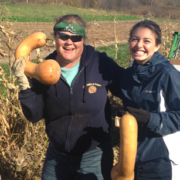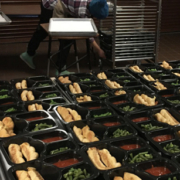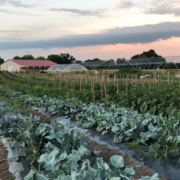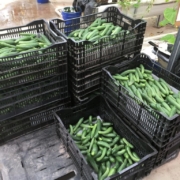Bringing the Farm to School Through New Connections
 Print This Post
Print This Post
By Tammy Howard, NCAT Senior Manager
With October being National Farm to School month, I was reminded of what the National Farm to School Network refers to as triple bottom line — kids win, farmers win, and communities win with Farm to School. Despite the relatively high demand of local products on school menus, there are still relatively few opportunities and resources for producers to be trained in accessing school markets.
Bringing the Farm to School Through New Connections is a USDA Food and Nutrition Services funded program to help equip producers to sell to schools. NCAT and our valued partners at the National Farm to School Network (NFSN) are collaborating with producer organizations throughout the country to expand the widely adaptable Bringing the Farm to School (BTFS) curriculum. In this second phase of this project, NCAT and NFSN are working with local and regional producer organizations to connect producers and school food buyers through networking events and technical assistance.
In the first phase of Bringing the Farm to School, NCAT and NFSN, along with the USDA Food and Nutrition Services Community Food Systems Division, developed a curriculum to help state agencies train producers. The project trained over 300 state agencies and stakeholders on the curriculum and training best practices and provided technical assistance to these state teams as they implemented more than 50 producer trainings in 23 states. The informal networking between producers and school food buyers was one of the more impactful components of the producer training. Bringing the Farm to School Through New Connections will expand on this component by focusing on deepening the relationships between farmers and school food buyers through formalized networking events.
Earlier this summer, we piloted a producer buyer networking event in collaboration with Texas State University’s Small Producer’s Initiative. Our goal was to bring networking opportunities to where producers were already convening — at the annual Southern Farm Family and Food Systems Conference, which draws close to 575 attendees. NCAT Local Food Specialist Robert Maggiani and our collaborator at Kitchen Sync Strategies, Elliott Smith, organized a series of events that brought producers and buyers together.
We featured the BTFS curriculum at the conference to introduce producers to different opportunities and pathways to sell their products to schools. In addition, Maggiani organized a panel of buyers to help producers understand what buyers are looking for and opportunities to help buyers find producers. These events provided a foundation for producers to understand which marketing channels worked best for selling their products to schools. After the panel, the school food buyers, including regional distributors, Texas Department of Agriculture and producers, stayed for a mixer to learn from each other and further those connections. The final component of this networking event included a site visit the following day at a school district in Central Texas that prioritizes local food purchasing. Maggiani described it as “an opportunity for producers and regional distributors to see under the hood of a school district kitchen and see how their raw product is used to serve school meals for thousands of kids per day.”

Photo: NCAT
A school district site visit was a departure from NCAT’s original Bringing the Farm to School curriculum. In the original project, we suggested that site visits at farms that sell to schools were an important peer learning opportunity for producers, but they were not impactful in helping them understand the buyer’s perspective and understand how their product is utilized. For this program, the school site visit participants were curated by NCAT’s local foods staff in Texas and Kitchen Sync Strategies. Participants included an equal mix of regional local food distributors, aggregators, producers, and school nutrition directors. The agenda included presentations from the school food services director and a break out discussion focusing on some of the opportunities and challenges in school sales from each supply chain representative. The site visit started with a school food breakfast and ended with a fantastic lunch featuring locally sourced products. These meals facilitated further connections and provided many informal opportunities for the networking to continue. As a follow-up, our team will continue to work with producers that attended this event to coach them through the sticking points of selling their products to schools.
This pilot demonstrated that this new approach to Bringing the Farm to School Through New Connections can be the foundation of the important work of building relationships to increase school food sales. The combination of providing context through classrooms sessions, connections through networking events, and coaching and technical assistance will help producers “make that sale” and provide healthy local foods to schools in central Texas. As we expand this approach to other regions throughout the country, we will build on the lessons learned from this pilot and provide tools and connections for producers to begin, or expand, selling their products to schools.
Related ATTRA Resources:
Scaling up for Regional Markets Tutorial
Scaling up your Vegetable Farm for Regional Markets
Farm to School Sales: Profiles of Ranches Making It Work
Episode 358. Abundant Montana “Meet Up” Meets with Success
This blog is produced by the National Center for Appropriate Technology through the ATTRA Sustainable Agriculture program, under a cooperative agreement with USDA Rural Development. ATTRA.NCAT.ORG.









 NCAT
NCAT NCAT
NCAT
